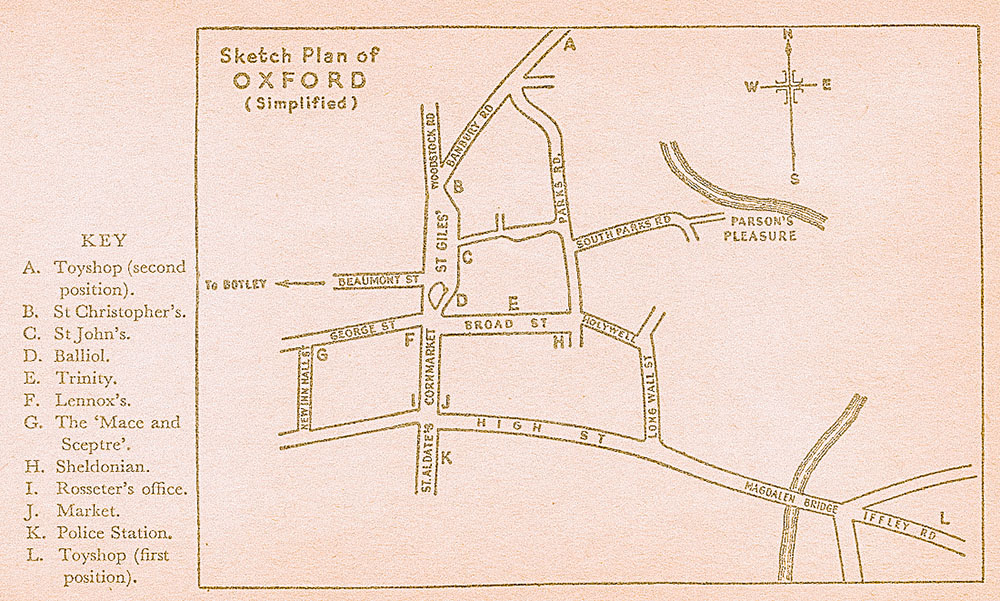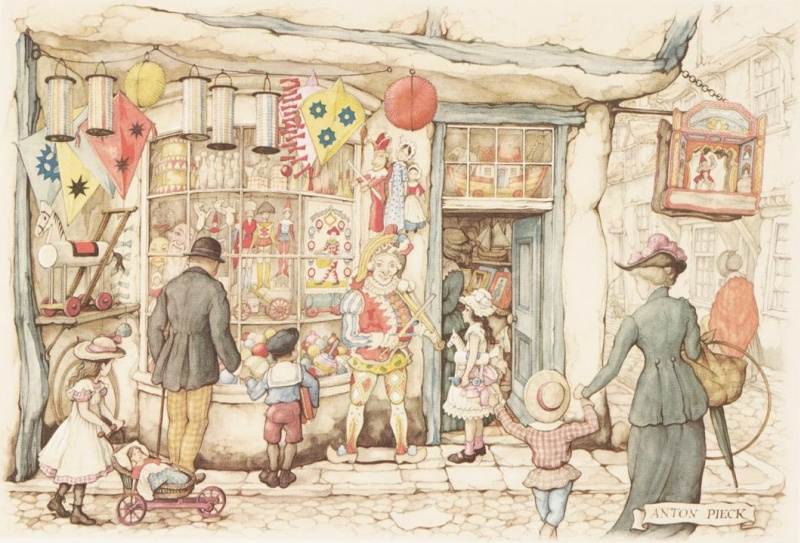The Moving Toyshop is the first novel by Edmund Crispin that I’ve read, and I was pleasantly surprised by how much I enjoyed it—far more than I expected. Having primarily grown up on Agatha Christie and Ngaio Marsh for cozy mysteries, I was looking for something equally engaging, with easy-to-read prose, charming settings, and well-drawn characters. This book fit the bill perfectly.
This year I’m participating in several reading challenges. This is an entry for the Cloak and Dagger Reading Challenge and the Goodreads 2025 Reading Challenge.
The Moving Toyshop: Summary and My Thoughts
The story opens with Richard Cadogan, a poet struggling with boredom and, like many literary creatives, writer’s block. Seeking a change of scenery, he decides to take a vacation and makes his way to Oxford. His journey is anything but straightforward—there’s no direct train, yet his adventurous spirit pushes him to continue.
While wandering through town, Cadogan stumbles upon a toyshop with its door mysteriously ajar. Intrigued, he steps inside, only to make a chilling discovery—a dead woman lying in the sitting room. Before he can process what he’s seen, he’s knocked unconscious by an unknown assailant.

When he regains consciousness and reports the crime to the police, he finds himself at the center of an utterly baffling mystery—the toyshop has vanished without a trace, and in its place now stands an ordinary grocer’s shop. The Moving Toyshop indeed.
This is where Richard Cadogan turns to Gervase Fen for help. Fen, ever the enthusiastic detective, promptly abandons his professorial duties and throws himself into the case—quite literally, as he dashes off to Oxford, eager to unravel the mystery.
It soon becomes clear that the murdered woman was the rightful heir to her aunt’s sizable estate. However, with her untimely death, the inheritance was redirected to several other beneficiaries. Adding a whimsical touch to the intrigue, the eccentric aunt, a lover of comic verse, had devised a rather unconventional way of signaling her chosen heirs—through limericks that acted as cryptic clues.
Although I’m familiar with Edward Lear’s limericks, I wouldn’t claim any expertise in deciphering them—especially when it comes to linking them to the cryptic clues identifying the beneficiaries: Ryde, Leeds, West, Mold, and Berlin. Fortunately, Gervase Fen, as an English Literature don, is the perfect person for the job.
As Fen unravels the poetic puzzle, it leads him to a group of individuals, each with a compelling motive for murder. The deeper he digs, the clearer it becomes that the inheritance wasn’t just a matter of fortune—it was a matter of life and death.

Through a series of fortunate coincidences, Fen and Cadogan cross paths with Sally Carstairs, one of the beneficiaries. She proves to be a key source of information, shedding light on what really happened the night of the murder and revealing those involved in the larger scheme.
At first, I assumed The Moving Toyshop might be overly academic or dry, given its Oxford setting and its sleuth, Gervase Fen, an Oxford don. Adding to my initial hesitation was the fact that the man who brings this particularly baffling mystery to Fen—Richard Cadogan—is a distinguished poet. I expected a slow, overly intellectual read, but instead, I found a lively, witty, and delightfully unconventional mystery that kept me thoroughly entertained.
The Moving Toyshop certainly doesn’t shy away from scholarly references. In fact, Gervase Fen himself provides plenty of opportunities for literary and academic allusions. As an English Literature professor, he naturally weaves complex words and references to celebrated works into his dialogue.
I came across quite a few multi-syllabic words that left me stumped—not only did I have no clue what they meant, but I doubt I could even use them in a casual game of Scrabble. Amusingly, while browsing Goodreads reviews, I found one particularly detailed review that described some of Fen’s utterances as “sesquipedalianism.” Given the sheer length of that word, I couldn’t help but appreciate how fitting it was for what it described.
While reading The Moving Toyshop, I couldn’t help but be reminded of my own university days. Edmund Crispin masterfully transports the reader to Oxford, capturing its charm and energy in a way that feels immersive. While I can’t speak to how accurately his depiction reflects the real Oxford, his descriptions made it easy to picture myself striding through the streets, gazing into shop windows, and weaving through crowds of students.

Though Oxford is worlds apart from where I studied, the atmosphere felt strikingly familiar. My own campus had a similarly relaxed vibe—so much so that no one batted an eye if a student turned up to class in pajamas. Crispin’s The Moving Toyshop‘s portrayal of Oxford’s academic world, with its mix of eccentricity and tradition, resonated with my own experiences of university life.
Like Oxford, my university was also bustling with stores, always open to the public, and, occasionally, crime did happen. It always felt like a microcosm of society, where the everyday and the extraordinary coexisted. Of course, as the top university in the country, there was no escaping the air of academic superiority. Many students were eager to share their views—sometimes passionately, sometimes pretentiously—but always with the earnestness that comes with being part of an intellectual community.
At its core, the motive behind the crime is simple—once the mystery of the moving toyshop is unraveled, it all comes down to greed. As the saying goes, the love of money is the root of all evil.
Some readers might find the resolution a little too convenient or coincidental, especially compared to mysteries where physical evidence or more concrete clues lead to the culprit. Unlike those tightly plotted detective stories, The Moving Toyshop leans into a more whimsical, almost effortless unraveling of events. However, despite the unconventional approach, I still found it thoroughly entertaining and followed the mystery to its satisfying end.
Intriguing words that I stumbled upon
Gervase Fen’s vocabulary in The Moving Toyshop had me reaching for my browser more than once to look up unfamiliar words. His expansive lexicon added to the novel’s charm, and I picked up a few intriguing terms along the way. Here are some of the words I discovered.
- Gallimaufry – a confused jumble or medley of things
…with a lot of queer provisions about advertising for her only in English papers, not communicating direct, and Lord knows what a gallimaufry of rubbish. (Chapter 4, The Episode of the Indignant Janeite)
- Picaresque – relating to an episodic style of fiction dealing with the adventures of a rough and dishonest but appealing hero
‘Can you provide me adventure, excitement, lovely women? ‘ ‘ These picaresque fancies,’ said Mr. Spode… (Chapter 1, The Episode of the Prowling Poet)
- Suilline – of or pertaining to pigs
Her face was fat, yellow-complexioned, and moonlike, with a rudimentary black moustache, a pudgy nose, and small suilline eyes… (Chapter 9, The Episode of the Malevolent Medium)



2 comments
I have this one on my to-read list. Limericks as clues sounds fun.
Yes, I enjoyed this book a lot even though I was a bit lost on some of the words!